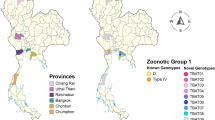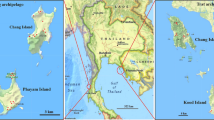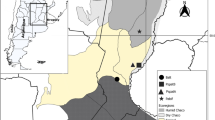Abstract
In the present study, the entire first and second internal transcribed spacer (ITS-1 and ITS-2) regions of nuclear ribosomal DNA (rDNA) of Haemaphysalis longicornis from China were amplified by polymerase chain reaction. The 45 representative amplicons were sequenced, and sequence variation in the ITS was examined. The ITS sequences of H. longicornis were 3644 bp in size, including the part of 18S rDNA, 28S rDNA sequences and the complete ITS-1, 5.8S rDNA and ITS-2 sequences. Sequence analysis revealed that the ITS-1, 5.8S rDNA and ITS-2 of this hard tick were 1582, 152, and 1610 bp in size, respectively. The intra-specific sequence variations of ITS-1 and ITS-2 within H. longicornis were 0–2 and 0–2.2%; however, the inter-specific sequence differences among members of the genus Haemaphysalis were significantly higher, being 35.1–55.2 and 37–52% for ITS-1 and ITS-2, respectively. The molecular approach employed in this study provides the foundation for further studies of the genetic variation of H. longicornis from different hosts and geographical origins in China.
Similar content being viewed by others
Avoid common mistakes on your manuscript.
Introduction
Tick are obligate hematophagous ectoparasites, which usually carry a number of pathogenic microorganisms and parasites, causing diseases in animals and humans (Hajdušek et al. 2013). Ticks belong to three families: Ixodidae, Argasidae and Nuttalliellidae (Burger et al. 2012). Among these three families, the Ixodidae is the most important, and it is consisting of 705 species. Recently, many studies have confirmed that the Ixodidae can transmit a variety of pathogens, including bacteria, helminths, protozoa, and viruses (Greay et al. 2016; Silaghi et al. 2016). Haemaphysalis longicornis (Acari: Ixodidae) has a wide distribution in different countries and regions around the world, including China, India, Japan, Vietnam and the far east region of Russia. Haemaphysalis longicornis possess a variety of hosts, including sheep, goat, cattle, horse, cat and chickens (Wang et al. 2015).
Genetic variation is a very general phenomenon in metazoans, including ticks. The internal transcribed spacers (ITS) of nuclear ribosomal DNA (rDNA) is a useful molecular marker, which can provide valuable information for investigating population genetic structures, systematics and phylogenetics of hard ticks. The ITS-1 sequences of Ixodes scapularis had been used to confirm that the Ixodes scapularis constitute a single species in USA (McLain et al. 1995). Furthermore, Chitimia et al. (2009) utilized the ITS-1 sequences as a well-defined genetic marker to analyze molecular characterization of hard and soft ticks from Romania. For example, Song had employed ITS-2 sequences to distinguish I. holocyclus isolated from different geographic ranges (Song et al. 2011). Although ITS sequences in a number of ticks have been well studied, there is a paucity of information on ITS sequence variation among populations of H. longicornis of socio-economic significance.
The objectives of the present study were to characterize H. longicornis from wild hedgehogs and goats in three provinces of China by their ITS sequences and to study genetic variation within and between H. longicornis and other hard ticks.
Materials and methods
Parasites and DNA extraction
All adult ticks of H. longicornis (n = 45) were obtained from wild hedgehogs and goats in three provinces (Henan, Shandong and Hunan) of China. The ticks were washed in physiological saline, identified preliminarily to species based on host preference, morphological characters and predilection sites (capitulum, pedipalp, stigma plate) (Deng 1978), fixed in 70% (v/v) ethanol and stored at − 20 °C until use. Total genomic DNA was isolated from this tick using sodium dodecyl sulphate/proteinase K treatment, followed by spin-column purification (Wizard® SV Genomic DNA Purification System, Promega, Madison, Wisconsin, USA).
PCR amplification and sequencing
The complete ITS regions including primer flanking 18S rDNA, ITS-1, 5.8S rDNA, ITS-2 and 28S rDNA sequences was amplified by polymerase chain reaction (PCR) from individual tick DNA preparations using two primers, namely ITS1F (5′-TCATAAGCTCGCGTTGATT-3′), ITS1R (5′-AGCTGGCTGCGTTCTTCAT-3′), ITS2F (5′-CGAGACTTGGTGTGAATTGCA-3′) and ITS2R (5′-TCCCATACACCA-CATTTCCCG-3′) (Chitimia et al. 2009). The PCR reactions contained ~ 20 ng of genomic DNA and were carried out in 50-μL reaction volumes containing 25 μL 2 × Phusion EmwealdAmp MAX HS PCR Master Mix (TaKaRa, Dalian, China), 2 μL of each primer, 2 μL DNA and 19 μL of ddH2O and 2 µL of DNA sample in a thermocycler (Biometra, Göttingen, German). The PCR conditions were as follow: At the beginning of the preheat temperature 94 °C for 5 min, followed by 35 cycles of denaturation at 94 °C for 30 s; annealing at 54 °C for 30 s, and the extension temperature at 72 °C for 2 min, and a final extension at 72 °C for 5 min. These products of by PCR amplification were detected by 1.5% agarose gel electrophoresis to validate amplification efficiency. The PCR products were sent to BGI-Shenzhen (Shenzhen, China) for sequencing from both directions.
Complete ITS sequences analysis
The ITS-1 and ITS-2 sequences of H. longicornis were determined by comparison with those of H. longicornis (GenBank accession number JQ737121). Using the computer program Clustal X 1.81 (Thompson et al. 1997) to align all sequences of ITS regions of 45 strains H. longicornis. The formula D = 1 − (M/L) was used to calculate sequence differences of 45 strains H. longicornis isolated from China. In the formula, differently capital represent differently means, where M is the number of alignment positions at which the two sequences have a base in common, and L is the total number of alignment positions over which the two sequences are compared (Chilton et al. 1995). Furthermore, the Meg align procedure within DNAStar 5.0 (Burland 2000) was used to analyses sequence similarity of different tick species. Moreover, the Maximum likelihood (ML) method was used for phylogenetic re-constructions. ML analyses were performed using PhyML 3.0 (Guindon et al. 2010), and the GTR + I model with its parameter for the concatenated dataset was determined for the ML analysis using JModeltest (Posada 2008) based on the Akaike information criterion (AIC). Bootstrap support (BS) for ML trees was calculated using 100 bootstrap replicates. To study the phylogenetic relationships with other Haemaphysalis species. For ITS-1 region of H. longicornis, the H. parva (FN_296280), H. punctata (FN_296264) and H. flava (JQ_737122) were considered into the present study; For ITS-2 region of H. longicornis, the H. doenitzi (JQ_346685), H. flava (JQ_737122) were considered into the present study; The Rhipicephalus haemaphysaloides haemaphysaloides (JQ_737126) were considered as the outgroup. Phylograms were drawn using the Tree View program version 1.65 (Page 1996).
Results and discussion
A total of genomic DNA was isolated from 45 adult female H. longicornis, which collected from wild hedgehogs and goats in Henan, Hunan and Shandong provinces, China. The ITS-1 and ITS-2 regions were amplified, and subjected to agarose gel electrophoresis. Amplicon of all samples appeared as a single band, approximately 1600 and 1700 bp in length, respectively.
The sequences of ITS-1 and ITS-2 were 1582 and 1610 bp in size, respectively. These sequences have been deposited in GenBank under the accession numbers: For ITS-1, MF490294–MF490308 (from Hunan province), MF490309–MF490323 (from Shandong province) and MF490324–MF490338 (from Henan province); For ITS-2, MF490339–MF490353 (from Hunan province), MF490354–MF490368 (from Shandong province) and MF490369–MF490383 (from Henan province). The intra-specific sequence variation within H. longicornis were 0–2% for ITS-1, and 0–2.2% for ITS-2. However, comparing with other member of Haemaphysalis, the results shown that the inter-specific sequence differences among members of the genus Haemaphysalis were significantly higher, being 35.1–55.2, 37–52% for ITS-1, ITS-2.
Comparative analysis of different geographical isolates of H. longicornis from the same province revealed genetic variations for ITS-1, ITS-2. The result shown that sequence variation in ITS-1 was 0–0.16% among samples from Hunan province, 0–0.58% among samples from Henan province and 0–0.59% among samples from Shandong province. Sequence variation in ITS-2 was 0–0.54% for samples from Hunan province, 0–0.22% for samples from Henan province and 0–0.33% for samples from Shandong province. Among three provinces, the highest variation of gene sequences is Shandong province for ITS-1. However, the highest variation of gene sequences is Hunan province for ITS-2.
Many studies have demonstrated that ITS sequences are valuable genetic markers for phylogenetic studies of different groups of ectoparasites, including ticks (such as Ixodes ricinus, Dermacentor marginatus, H. punctata, H. parva and Dermanyssus gallinae) (Chitimia et al. 2009; Murrell et al. 2001). In the present study, phylogenetic analyses of the sequences of ITS1 and ITS2 among 45 individual H. longicornis isolates from China, four other ticks using ML is shown in Fig. 1. In these trees, the H. longicornis form monophyletic group with high statistical support (BS = 100), indicated that all present isolates represent hard tick H. longicornis.
In conclusion, sequence variations among H. longicornis isolates from different geographical localities in China were revealed by sequence analyses of ITS sequences. The molecular approach employed in this study provides the foundation for further studies the genetic variation of H. longicornis in different geographical origins in China.
References
Burger TD, Shao R, Beati L, Miller H, Barker SC (2012) Phylogenetic analysis of ticks (Acari: Ixodida) using mitochondrial genomes and nuclear rRNA genes indicates that the genus Amblyomma is polyphyletic. Mol Phylogenet Evol 64:45–55
Burland TG (2000) DNASTAR’s Lasergene sequence analysis software. Methods Mol Biol 132:71–91
Chilton NB, Gasser RB, Beveridge I (1995) Differences in a ribosomal DNA sequence of morphologically indistinguishable species within the Hypodontus macropi complex (Nematoda: Strongyloidea). Int J Parasitol 25:647–651
Chitimia L, Lin RQ, Cosoroaba I, Wu XY, Song HQ, Yuan ZG, Zhu XQ (2009) Genetic characterization of ticks from southwestern Romania by sequences of mitochondrial cox1 and nad5 genes. Exp Appl Acarol 52:305–311
Deng GF (1978) Economic insect fauna of China, vol 15. Science Press, Beijing, pp 1–174
Greay TL, Oskam CL, Gofton AW, Rees RL, Ryan UM, Irwin Peter J (2016) A survey of ticks (Acari: Ixodidae) of companion animals in Australia. Parasit Vectors 9:207
Guindon S, Dufayard JF, Lefort V, Anisimova M, Hordijk W, Gascuel O (2010) New algorithms and methods to estimate maximum-likelihood phylogenies: assessing the performance of PhyML 3.0. Syst Biol 59:307–321
Hajdušek O, Šíma R, Ayllón N, Jalovecká M, Perner J, de la Fuente J, Kopáček P (2013) Interaction of the tick immune system with transmitted pathogens. Front Cell Infect Microbiol 3:26–41
McLain DK, Wesson DM, Oliver JH Jr, Collins FH (1995) Variation in ribosomal DNA internal transcribed spacers 1 among eastern populations of Ixodes scapularis (Acari: Ixodidae). J Med Entomol 32(3):353–360
Murrell A, Campbell NJH, Barker SC (2001) Recurrent gains and losses of large (84–109 bp) repeats in the rDNA internal transcribed spacer 2 (ITS2) of rhipicephaline ticks. Insect Mol Biol 10:587–596
Page RD (1996) TREEVIEW: an application to display phylogenetic trees on personal computers. Comput Appl Biosci 12:357–358
Posada D (2008) JModelTest phylogenetic model averaging. Mol Biol Evol 25:1253–1256
Silaghi C, Beck R, Oteo JA, Pfeffer M, Sprong H (2016) Neoehrlichiosis: an emergingtick-borne zoonosis caused by Candidatus Neoehrlichia mikurensis. Exp Appl Acarol 68:279–297
Song S, Shao R, Atwell R, Barker S, Vankan D (2011) Phylogenetic and phylogeographic relationships in Ixodes holocyclus and Ixodes cornuatus (Acari: Ixodidae) inferred from COX1 and ITS2 sequences. Int J Parasitol 41:871–880
Thompson JD, Gibson TJ, Plewniak F, Jeanmougin F, Higgins DG (1997) The Clustal X windows interface: flexible strategies for multiple sequence alignment aided by quality analysis tools. Nucleic Acids Res 24:4876–4882
Wang S, Li J, Niu G, Wang X, Ding S, Jiang X, Li C, Zhang Q, Liang M, Bi Z, Li D (2015) SFTS virus in ticks in an endemic area of China. Am J Trop Med Hyg 92:684–689
Acknowledgements
This work was supported in part by Scientific Research Fund of Hunan Provincial Education Department (No. 16A102), and the National Natural Science Foundation of China (No. 31372431).
Author information
Authors and Affiliations
Corresponding author
Rights and permissions
Open Access This article is distributed under the terms of the Creative Commons Attribution 4.0 International License (http://creativecommons.org/licenses/by/4.0/), which permits unrestricted use, distribution, and reproduction in any medium, provided you give appropriate credit to the original author(s) and the source, provide a link to the Creative Commons license, and indicate if changes were made.
About this article
Cite this article
Li, ZB., Liu, GH. & Cheng, TY. Molecular characterization of hard tick Haemaphysalis longicornis from China by sequences of the internal transcribed spacers of ribosomal DNA. Exp Appl Acarol 74, 171–176 (2018). https://doi.org/10.1007/s10493-018-0210-x
Received:
Accepted:
Published:
Issue Date:
DOI: https://doi.org/10.1007/s10493-018-0210-x






